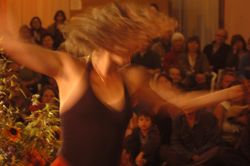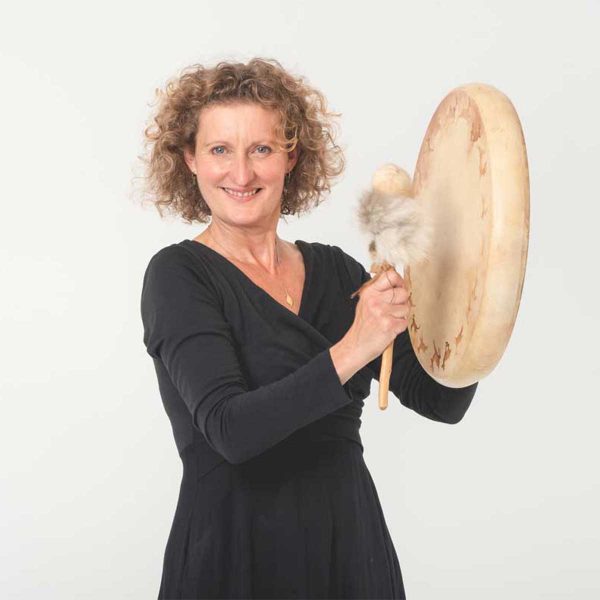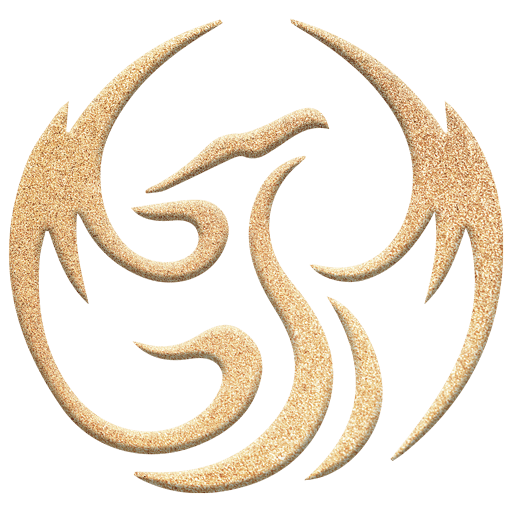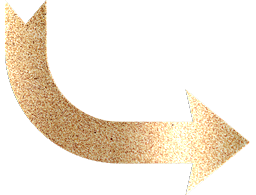This article may be a challenge to read. It’s deep stuff: the result of many years of study about the potency of our assumptions and the power of the negative way many of us talk to ourselves. We believe that these perspectives may be really useful to those with the patience to chew this over. Good luck!
A lovely woman who interviewed me recently asked me for my thoughts. She said: “I have come to the point of seeing that what I long for the most is at the same time what I’m afraid of the most – the same thing pulling me in two opposite [directions]. My deepest desire AND my biggest fear are the SAME. It seems crazy. And it is tying me in knots, limiting me from living fully... I feel you know what I mean. Please tell me your thoughts.”
So here they are. My current meditations on the matter!
We humans are complex beings. We have evolved over billion years, and our beings retain layers of patterning from our ancestral and personal histories: reptilian, mammalian, plus our many human patterns, which sometimes, or even often, pull us in opposite directions. We want to grow, but at the same time, we are scared of the unknown. We want to love, but at the same time we want to protect ourselves from being hurt. We want to be individuals, but at the same time we need to belong. We want to belong, but at the same time we need to exercise our autonomy.
Under-studies and “SPASMs”
Many of the patterns that arise in us from our personal histories take the form of what we often refer to as our “understudies” – those aspects of ourselves that developed as survival strategies in our babyhood and childhood. Some of our understudies take the form of SPASMs, i.e. the “Self’s Protective AdaptiveSurvival Mechanisms”. Spasms in the physical body are created around physical injury to help hold the area stable whilst healing occurs. Once healing has happened, however, the body does not seem to have a mechanism for integrating this knowledge and releasing the spasm. That’s why we need body-work to help the body update and undo those out-of-date knots. The same thing seems to happen with injuries to the psyche with the result that we operate with psychological spasms that were generated in a totally different life context, mostly when we were little and did not have the power to actively protect ourselves or communicate clearly. These psychic spasms are probably ‘out of date’ but still powerfully functioning. They operate “under the radar” of our consciousness and they tend to fulfill themselves. They operate as unconscious self-fulfilling assumptions because they condition our perceptions, interpretations, emotional responses and actions, and we do not know that this is happening. The unconscious selection and interpretation of information about what is going on is very powerful because it operates pre-consciously, and therefore it seems to us that what we experience is just the way the world is and we don’t receive the updates of new and different information. In other words, our SPASMs are like glasses we have worn so long that we do not know we are still wearing them.
Tools of transformation
In Movement Medicine, one powerful tool we have for decoding these patterns is a methodology called “mapping the dance of the understudy”. Through seeing the steps of the dance that ends up re-confirming itself over and over again in our lives, we gain a “viewing point” through which we can compassionately witness this repetitive dance, begin to dis-identify from it and open to other possibilities that we can then reality check. In everyday English language use, the term “understudy” refers to an actor who steps in to take the part of the main actor if the main actor is unwell or injured. This is the reason that we use the name “understudies”; they act as under-studies for the soul until the soul is ready to take the main stage. This process does not happen by itself. The choice to bring our soul into the driving seat of our existence often feels like an almost impossible choice. In their commitment to protect us from harm, our SPASMs are often very defensive of their roles. They are like soldiers who do not know that the war is over. So they need respect, compassion, gratitude and clarity, as well as help from a part of ourselves that has access to the compassion of the wise elder, the choice, clarity and steadiness of the dancing warrior and the imagination of the fool.
The Phoenix Retreat is the chief place we teach this liberating practice. This year, it is being taught by Ya’Acov. He writes:
“The Phoenix Retreat is a place for people who are truly committed to getting a hold of their ego and making the choice to make the essential self or soul the final authority in life. It’s a challenging and safe place to deepen this enquiry through the dance, and the Phoenix Process itself is a truly phenomenally useful tool for supporting that process in your life. Doing this level of the work is all about responsibility: being and becoming more responsible for who we are in relationship to ourselves, each other and the wider community of life of which we are a part. I very much look forward to seeing you there and taking this journey with those of you who feel that call.”
The super-ego
There is another kind of understudy, which is often called the super-ego. This is different from a SPASM in that it is an “introject” – to use the Gestalt term. That means it is something that has been taken in from outside, un-chewed and “swallowed whole”. Typically the super-ego is full of judgement, ‘shoulds’ and rigid standards about how things should be. It judges the self, it judges others, and it can really impair the flow of life energy. Many people have super-egos which are vicious: punitive, emotionally violent, and damaging to themselves or/and to others.
For those with extremely self-punishing super-egos, which can turn on self-loathing and immobilizing shame at the drop of a hat, the super-ego is an internal demon that can dis-empower and paralyse a person for their whole life. So what is the super-ego and how did it come to be here in our psyches? What purpose could it possibly serve? And how can we become its master rather than its slave?
Below I explore my musings about these questions.
What is the super-ego and how did it come to be here in our psyches?
We are social beings. We have evolved to be very strongly affected by the culture in which we find ourselves. In indigenous life, this means the culture of the tribe in which we find ourselves. In modern life, this mostly means the nuclear family, or whatever part or aspect of family or institution was around us as we grew up. We have an intrinsic need to connect with our people, to come into resonance with them. This is recognized by practitioners as diverse as Winnicott (attachment theory) and Carlos Castaneda’s master teacher Don Juan. Don Juan talks about the existential imperative for the infant’s “assemblage point” (the energetic point in the being around which reality is assembled) to shift from its original “buddha station” to the assemblage point of his or her people, which Don Juan calls the “modality of the time”. This is a reflection of our inherent social nature and absolute need to belong. We imbibe the modality of the time through the energetic fields of our parents and those of others we are close to. We imbibe it through what is said and not said, and, in modern times, through the array of ‘shoulds’ and directives that we are exposed to.
What purpose could the super-ego possibly serve?
In my perception the super-ego is an understudy for our own moral compass or sense of conscience. It was designed to make sure that we belonged to our people, and to orientate our choices within the field of our people, until (or if) we became ready, as mature human beings, to assume the authority and responsibility to decide, consciously, for ourselves. In an integrated tribal culture, where the culture, cosmic vision, world view, and people’s actions and words was un-fragmented and consistent (if such a thing ever existed), one can imagine that imbibing the cultural super-ego would prepare one smoothly for life as part of that culture.
Bert Hellinger (founder of Family Constellations) explains the reasons we may feel an inexplicable and apparently irrational fear of death when we leave our family patterns, however toxic they may be. He said that this can occur however clearly good and healthy our new choices may be. This is because, as we leave our tribe’s dictates, our ancient memory fears that, as a result of breaking this ‘tribal custom,” we will be expelled. For our hunter-gatherer ancestors, that would have meant almost certain death. To be a lone human in the savannah was to be a dead human very quickly. Understanding this gives me more scope to be compassionate and understanding with my fearful self. This does not mean colluding with it, but being big enough to scoop it up into my arms, reassure it about the current reality, and take the step that is right and timely for me to take. And let’s be clear, it’s not that some groups do not anymore “ex-communicate” those who break their explicit or implicit taboos. But rather that, for better or worse, we are no longer hunter-gatherers dependent on belonging to our small group for survival. We can choose to be autonomous, inter-connected human beings, and find others to co-create this with.
In a damaged culture where (this is a British statistic) on average, children hear 10 negatives for every positive (10 “no’s” for every “yes”, 10 “you are wrong” for every “you are right”, 10 “you are bad” messages for every “you are good” messages), it is no wonder that the average super-ego is so self-punitive. A damaged culture breeds individuals with damaged and damaging super-egos. This in turn feeds the consumer culture that is eating up the world, as we seek to allay our inner sense of lack with more and more “stuff.”
How do we get a grip on this? What is the remedy? When one is in the grip of a “super-ego attack” one often feels completely powerless, as if at the mercy of a great destructive monster. In the face of this, often the best thing seems to be to curl up and pretend to be dead. However, in the long term, this does not solve anything; the monster remains and remains in charge.
So how can we become the master rather than the slave of the super-ego?
Imagine a horse and carriage. The driver is holding the reins, and encouraging the horses, or slowing them, or steering them. If the super-ego has the reins, the super-ego is in control, and you, in the carriage, just have to endure the ride as best you can. The super-ego is driving the carriage with the aim of keeping you on track, keeping you safe and keeping you “acceptable” according to what it knows, according to the map it absorbed when you were young – a map which is probably out of date.
The surprising thing is that, if one has the will and energy to take up the reins and take control you can. However, the super-ego is never going to tell you that. That is not how it works. From working with many of our apprentices on this over the last years we have found that the triad of the wise elder, the dancing fool and the dancing warrior are the appropriate parts of ourselves to call in. The wise elder witnesses what is happening, and perceives that the super-ego is in charge and we are hurting ourselves or others. The dancing fool suggests that there might be other truths here, and that other versions of reality are available everywhere we look. And the dancing warrior has the capacity for choice and authority to take the reins and start steering a course in accordance with our true values, with our soul.
Whenever we do this, it’s a moment of maturation. It means we have decided to take responsibility. It means we have accepted being the authority at the centre of our circle, which I sometimes call “crowning ourselves”. Developing the power of the dancing warrior is about developing the power of the vertical axis: body, heart and mind integrated into your own heaven–earth connection. This is the journey of empowerment. It’s also about owning our fire, our anger and our strength. From this connectedness comes the power of choice and the power of discovering what our real core values are – what we really want to stand for as human beings – as well as the ability to acknowledge our power and bring it into the service of love. It means letting go of identification with the victim, and it means standing up inside our own moral compass.
Alpha dogs and dog whisperers
When we make the move and our dancing warrior takes the reins, often the super-ego backs down surprisingly easily. It’s like seeing a master dog whisperer working with a powerful alpha dog. Until the master arrives, the alpha dog rules, intimidating everyone with its growls, raised hackles and sharp teeth. Once the master arrives, suddenly the dog is relieved of this role, and becomes a happy, compliant member of the pack. Dorrie, our dear friend and Movement Medicine artist, used to have a dog who was half wolf. He was an absolute beauty with a huge heart. But he would have become the alpha being (and therefore potentially very dangerous) in their family pack in the blink of an eye had he not been reminded continually of Dorrie and Tom’s alpha status. Dorrie told me that she could not be complacent with this for one moment. So it is for those of us with big alpha domineering super-egos. If our dancing warrior lets go the reins for a moment, boomph! – the super-ego has them.
I count dog training (I was 15) as my first real training. I had a terrific teacher (human) and lots of training companions: whippets, corgis, my own brilliant fox terrier, and 3 gorgeous Russian borzois. What I learnt with them was all about congruency. You’ve got to mean what you say, and be consistent, clear and congruent with what you do, what you say, what you feel – in other words, aligning body, heart, actions and words. You’ve got to have a responsive mix of kindness, firmness, enthusiasm, gentleness and energy (every dog is different, and each dog is different moment to moment). And you’ve got to believe whole-heartedly in your role. This applies equally to developing our own dancing warrior.
Imagine you’re the super-ego
Imagine you’re the super-ego. Your job is to keep your human safe from being expelled from the tribe by ensuring that they follow the norm, even if that is painful, demoralising and depressing. You are committed to not failing at your role. You know what the norm is, because that is who you are as super-ego – the particular set of “shoulds” and norms your human swallowed when he or she was little.
One day your human gets it in their head to do something different and new and to challenge that norm. You go berserk, threatening them with the worst things you can, calling them names. You’ve just got to bring them down to size before they rock the boat and risk everything. That is, until the dancing warrior steps in, takes you to one side and gently but firmly insists that they are now the authority, and they are taking responsibility. You are thanked for all your hard work and relieved of your duties. You can relax. Your sense of danger lessens, and you let yourself take a break, knowing you’ll be back at the reins the moment there is a lapse of wakefulness from the dancing warrior. But right now, it’s OK. You get into the carriage and take a nap. In this way the active presence or not of the super-ego can ultimately become a barometer of the level of awareness we are holding, moment to moment.
You’re not mad or useless!
I hope it’s clear from all this that the devastating struggle that many of us have with our super-egos is not because we are mad or useless. To some extent it’s a reflection of the dysfunctionality of our culture. The harsher the super-ego we were served by our family of origin, the more challenging the task. So, there is no point in comparing ourselves with others. Each of us has our own unique starting point and dialogue with our own super-ego challenge. The super-ego is a challenge to our maturation as autonomous individuals who may finally become strong enough to trust our own moral compass, our own individuated sense of conscience and our own soul.
It’s all about energy
Who has got your energy? The super-ego is not really a “thing” inside you that you have to put up with or deal with. The super-ego operates as part of a system with a certain amount of energy. Think of a balloon – the kind of long, thin balloon that kids’ entertainers tie into animal-shaped knots at a certain kind of children’s birthday party. Imagine one of these balloons semi-inflated. Squeeze one end, and the air goes down the other end. Do you inflate your dancing warrior or your super-ego? What is your choice?
The problem with toxic super-egos is that when we fail to control them, they even use that as another reason to shame us and make us feel like failures. It’s a familiar bully tactic. And the trouble is, some of us have got so used to being bullied by our super-egos that we’ve normalised it. We don’t realise that this is not normal, healthy, or inevitable. If you need it, get help.
Choose your company with care
The transformations I have talked about above are, above all, supported by good company. Who do you choose to hang out with? What do they reinforce in you, what do you reinforce in them? We have long realized that this is why ongoing programs are so effective; and this is one of the main benefits of our Apprenticeship Programme. You can choose to become part of a community of empowerment and responsibility – a circle of individuals committed to being and becoming part of co-creative community.
If you want to give feedback to me about this article, please do so on the Movement Medicine FB group. It’s a private group that you can join via our website.
Thank you for all the dances and songs I’ve shared with many of you in the last weeks. Your courage, beauty and huge hearts have touched me very deeply. I hope to see you on a dance floor (or sense you in a webinar!) soon.
With love,
Susannah




